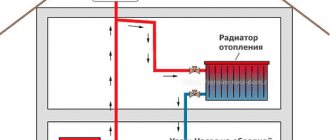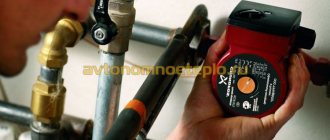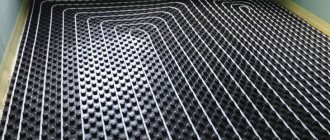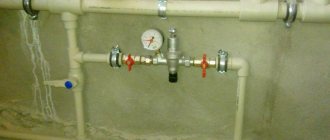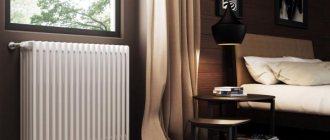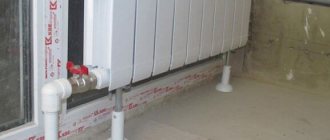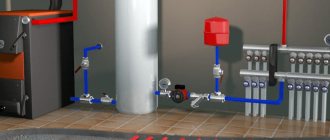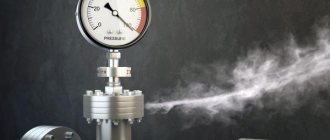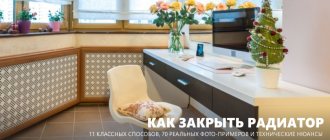The rapid gasification of Russian regions has created a demand for gas boilers of various modifications. The operating principle is based on the combustion of gas in a chamber and heating of a heat exchanger through which water circulates.
Depending on the purpose of the room, area, materials from which the building is constructed, wall-mounted or floor-mounted, single-circuit or double-circuit boilers are chosen, with an open or closed combustion chamber. Floor-standing gas installations are designed for a longer service life; they are part of a boiler room; wall-mounted ones are a mini-boiler room, take up little space, and are ideal for apartments and houses. Single-circuit boilers are intended only for heating, double-circuit boilers are intended for heating premises and producing hot water. Boilers also differ in the type of draft; turbocharged boilers have a closed combustion chamber, while atmospheric boilers have an open combustion chamber.
Regardless of what model of boiler is installed in the room, the safety of the heating boiler directly depends on proper operation and compliance with safety precautions. Gas installations are sources of increased danger and can pose a threat to life due to the careless and neglectful attitude of the consumer. Failure to comply with basic operating rules leads to gas leakage, the appearance of carbon monoxide (carbon monoxide), fire, and in rare cases, an explosion of the installation.
Gas boiler for heating system
The most common is the autonomous heating scheme, in which the central element is a modern double-circuit gas boiler. It is a fairly compact device that is mounted on the wall. This device has a special chamber in which the fuel combustion process occurs. Moreover, the advantage of this type of boiler is that there is no need to create a special flue. A modern individual heating system in an apartment allows the boiler to use air, which is supplied directly from the street through a small pipe. The boiler is equipped with a specially designed chimney, which allows you to carefully remove smoke without causing inconvenience to apartment residents or their neighbors.
Gas boiler in the apartment
It should be noted that the individual system circuit itself is equipped with a fairly large number of different sensors that monitor its operation at various levels.
The use of such sophisticated technology ensures the fastest and highest quality, and most importantly, safe operation of the system. For example, gas will not enter the combustion chamber until the system receives feedback about normal operation from all sensors present in it. After this, the circulation pump starts working - it is responsible for the continuous movement of the coolant. In parallel with this, a vacuum is created in the chamber using a special fan. And only after that a small spark is supplied, from which the gas flares up. Moreover, the entire verification process takes only a fraction of a second.
Commissioning - basic requirements
According to the rules of standard technical operation, commissioning of a boiler room is divided into two main activities:
- Preparation of design documents and their approval.
- Carrying out required technical and installation operations.
When installing a boiler room, work is carried out to ensure sound insulation and full compliance with safety regulations. After this, personnel are selected. Employees undergo relevant courses, after which they receive a license.
A bilateral agreement must be concluded with the residents of the house for the maintenance of the installed boiler room. The preparation of project documentation and official approvals is carried out by the contractor who built the building or an authorized representative of the management company.
Requirements for chimney installation
When installing a gas boiler of any type in an apartment in an apartment building, the chimney cannot be made narrower than its outlet pipe. If the device has an open combustion chamber and a power of no more than 30 kW, the cross-section of the chimney pipe cannot be less than 140 millimeters, and with a productivity of 40 kW - 160 millimeters in diameter.
If the boiler has a closed combustion chamber, it is equipped with a coaxial chimney with a cross-sectional size recommended by the manufacturer.
Next you need to adhere to the following rules:
- the pipe going upward from the wall-mounted gas unit must have a length of at least 50 centimeters, and only then can the elbow be installed;
- more than three bends cannot be created along the entire length of the chimneys;
- combustion products from appliances with open combustion chambers are removed into the chimney, and with closed ones, also into the chimney or through the wall directly to the street (the method depends on the project).
Roof boiler price
Compensation for the cost of heating (installation of autonomous equipment) falls on the shoulders of apartment owners in apartment buildings. You can pay for services by making additional contributions or by transferring from the balance sheet of the management company, where the owners make fixed payments. The following expenses are included in the calculation of the final amount:
- purchase of a boiler (price depends on the manufacturer and power);
- compensation for the cost of a thermal station;
- payment for additional services (sound insulation, fire extinguishing systems) - approximately a third of the price of the boiler room;
- payment for insurance services (commissioning is not allowed without concluding an insurance contract).
The price of all work from the start of paperwork is 5-7 million rubles.
Electrical systems
There are not only many varieties of electric boilers, but also many options that allow you to construct a project. For example, an apartment owner has several options for heating a room:
- warm floor;
- electric boiler;
- Heat pump.
The first two methods are not always advisable to install, since they are expensive to install, and you will also have to pay a lot for electricity. Electricity, like other energy resources, is constantly becoming more expensive. If you install an electric boiler, you must remove all the old equipment and install new ones, just as in the case of a gas installation.
Warm floors are more efficient than a boiler due to its features. If all heating elements are located evenly across the entire floor, and the air is heated from the bottom up, then much less energy will be needed to create comfortable conditions.
But it is better to do autonomous heating of an apartment in an apartment building in the form of a heat pump. Two types of such devices can be used: air-to-air and air-to-water.
People are often interested in the question of whether it is possible to install autonomous heating in an apartment at a low price. In this case, they should not look closely at thermal devices. The cost of heat pump equipment can be high. In addition, the price per unit of energy spent will also be slightly higher when compared with gas equipment.
But on the other hand, if we talk about the long term, then such equipment is interesting to install. Also, a device that operates on the air-to-air principle can perform the functions of an air conditioner in the summer, since their operating principle is the same. In this regard, a heat pump is sometimes called an air conditioner.
Before installing an air type device, you must choose the right model. It is better to install multi-channel equipment in apartments with a large area. Buying such a device for a small apartment is not advisable, since its cost will be significant and the electricity bill will not please you.
For small apartments, it is beneficial to install separate split panels for each room separately. In this case, there will be no need to install air ducts. This option is ideal if the renovation of the apartment has already been completed, since installation does not require breaking down the walls. In addition, one system can produce up to 5 kW of heat. In the northern regions, a combined heating system is used: in winter they use a gas boiler, and in summer - an electric one. Thus, it is possible to save a lot of resources.
Overview of installation of water heated floors in an apartment:
Illegal gas shutoff
The management company is obliged to notify residents in advance and in writing about the inspection work. Accordingly, if there was no notification, turning off the gas supply is illegal.
We list the cases when turning off gas is illegal:
- planned technical work in the apartment building has been completed;
- there is no debt to pay for the services of the gas supply company;
- gas equipment was found not to comply with the standard or contract, but the consumer disputes this fact in court;
- The emergency situation has been eliminated and the period established by the regulations for restoring gas supply has expired.
In addition, the reason for turning off the gas cannot be the lack of opportunity to inspect the gas equipment located in the apartment at a time when the owner was not on site. It must be said that the homeowner can refuse to inspect the gas equipment; the gas company has no leverage over it.
Remember: the management company does not have the right to make a decision to cut off the gas supply to all residents of an apartment building if only a few residents have debt.
Requirements for chimney installation
When installing a gas boiler of any type in an apartment in an apartment building, the chimney cannot be made narrower than its outlet pipe. If the device has an open combustion chamber and a power of no more than 30 kW, the cross-section of the chimney pipe cannot be less than 140 millimeters, and with a productivity of 40 kW - 160 millimeters in diameter.
If the boiler has a closed combustion chamber, it is equipped with a coaxial chimney with a cross-sectional size recommended by the manufacturer.
Next you need to adhere to the following rules:
- the pipe going upward from the wall-mounted gas unit must have a length of at least 50 centimeters, and only then can the elbow be installed;
- more than three bends cannot be created along the entire length of the chimneys;
- combustion products from appliances with open combustion chambers are removed into the chimney, and with closed ones, also into the chimney or through the wall directly to the street (the method depends on the project).
Heating a house 250 m² - 87,500 rub.
Really, honestly, really
| Heating of a house 250 m² from | RUB 87,500 |
| Installation of heating boiler | 8,000 rub. |
| Installation of heating radiators (no more than 20 pcs)!!! The cost of installing a standard (mounted, not in-floor convector) heating radiator is 4,000 rubles | 45,000 rub. |
| Radiator pipe routing | 30,000 rub. |
| Pressure testing and filling with coolant | 4,500 rub. |
| TOTAL turnkey: | 87,500 rub. |
| Drilling holes, rigging, dismantling, paid extra | according to_estimate |
Heating a house 250 m² Attention. This cost is a preliminary estimate; these prices should only be used as approximate prices. The exact cost of the work is calculated after an engineer visits the work site, its complexity, and quantity.
Cost of materials from 300,000 rubles
Included by type of work
| Boiler installation | Installing an electric boiler on a wall or floor |
| Installation of pipes without “grooving” | Open pipeline installation with wall or floor mounting |
| heating radiators | Mounting the heating device on the wall, installing fasteners |
| System pressure testing | Pressure testing of the assembled system with an air compressor to identify possible leaks |
| Commissioning works | Filling with coolant (antifreeze or water), removing air from the heating system during work |
| !!! No heated floors | It is calculated additionally, it requires coordination of the type of substrate for the pipes, the type of use of the pipe, the possibility of control and automatic control, and of course the footage |
| !!! Without external chimney | To calculate the cost, an engineer’s visit is required, an inspection of the roof structure, window location and much more. |
Heating a house 250 m²
8 [email protected] ROUND THE CLOCK
Russia, Moscow, ☞ Pyatnitskoe highway, 55A Russia, Moscow, Mitino, ☞ 3 Mitinsky lane, 1 (ARCHIVE) Russia, Moscow, ☞ Yana Rainis boulevard, 19, cor. 1 Russia, Moscow, ☞ Marina Raskova, 10 kor. 4 Russia, Moscow, ☞ 1st Grayvoronovsky proezd, 2A Russia, Volokolamsk, ☞ Novo-Soldatskaya street, 23с3 Russia, Golitsino, ☞ Petrovsky pr., vl 5 с 1 Russia, Elektrougli, ☞ st. Central, 50 Russia, Klin, ☞ Moskovskaya st., 31 Russia, Konakovo, ☞ Lenina, 7A Russia, Podolsk, ☞ st. Fedorova, 19 Russia, Tula region, ☞ Plavsk Russia, Chelyabinsk, ☞ Komsomolsky pr-t, 2, kor. 315 Russia, Ramensky urban district, ☞ Chulkovo village Russia, Republic of Crimea, Yalta urban district, urban settlement ☞ Beregovoye
Heat supply of an apartment building
The following heat supply methods exist:
- Installation of heat pipelines from central heating networks.
- Installation of an autonomous heating point.
Diagram of a double-circuit heating system.
These heat supply methods are equally effective, but having an individual heat supply point with autonomous heating for several apartment buildings is much more convenient. Since the distance between the heat supply point and the consumer itself is significantly reduced, which means heat losses along the heat transfer line are reduced. This heating method is called decentralized or autonomous.
Autonomous heating and its advantages:
- With autonomous heating of a room, the heat supply source is located at a minimum distance from the house, which reduces the time of heat supply and the percentage of heat losses, which results in further reductions associated with maintenance costs, maintenance and repair of heating networks.
- Since the heat supply point is located nearby, utility costs are noticeably reduced.
- Complete independence from the general city schedule. This means that it is always possible to connect apartment heating if necessary.
- Each apartment owner can set the optimal temperature in the heating system only for his home, while he has the opportunity to independently regulate the level of heat supply.
- There is an excellent opportunity to install a heated floor system.
- The presence of an autonomous heat supply point affects the lower cost of an apartment in a new building.
Autonomous heating and its disadvantages:
House heating scheme using a gas double-circuit boiler.
The best option for autonomous apartment heating is heating powered from a central gas pipeline or through the power supply network, which completely depends on the type of boiler. In apartments, it is most practical to use wall-mounted boilers for heating the home, which, in turn, are divided into gas and electric.
Until recently, there were practically no alternatives to centralized heating in our country. Accordingly, the service was paid at a single rate, despite the degree of use of the service. Today the market is replete with autonomous heating systems of different types and from different manufacturers.
Individual heating
Many homeowners who have financial resources install individual gas heating in their apartments in order to independently control the level of consumption and save on the “heating and hot water supply” column in regularly received receipts, which is growing every year.
The initiative was taken up, and now individual gas heating, even requiring expensive equipment and significant installation costs, is used more and more often. The benefit is obvious: sometimes the money spent can pay off fairly quickly, even within one heating season.
Autonomous heating of the house
Consumers have come to the conclusion that autonomous gas heating at home is very useful and profitable. The autonomous system is closed. Therefore, gas equipment for heating a house is a set consisting of an expansion tank, designed to compensate for the thermal expansion of the coolant, and a circulation pump, which ensures the movement of the working fluid along the heating circuit. Sometimes there is no need for a pump (if the heating system operates on the principle of natural coolant circulation). But today this is rarely practiced.
The advantage of such a gas heating system for a private house is that antifreeze (non-freezing liquid) can be used as a coolant, which makes it possible to do without draining it from the system in case of suspension of work in the winter.
Owners of country houses most often choose individual autonomous systems for heating their premises. In most regions of the Russian Federation, the heating season lasts about nine months, so you need to think about how to heat your house in advance. Every heating system is not perfect - it has its pros and cons. When making a choice, you need to take into account all the nuances: room layout, prices for equipment and installation, etc.
If your house is connected to a gas main, then this immediately tips the balance in favor of gas heating. Individual gas heating will be the best option in this case.
Heating a house 100 m²
Really, honestly, really
| Heating a house 100 m² from | RUR 49,500 |
| Installation of heating boiler | 8,000 rub. |
| Installation of heating radiators (no more than 10 pieces)!!! The cost of installing a standard (mounted, not in-floor convector) heating radiator is 4,000 rubles | 25,000 rub. |
| Radiator pipe routing | 12,000 rub. |
| Pressure testing and filling with coolant | 4,500 rub. |
| TOTAL turnkey: | RUB 49,500 |
| Drilling holes, rigging, dismantling, paid extra | according to_estimate |
Heating a house 100 m² Attention. This cost is a preliminary estimate; these prices should only be used as approximate prices. The exact cost of the work is calculated after an engineer visits the work site, its complexity, and quantity.
Cost of materials from 120,000 rubles
Included by type of work
| Boiler installation | Installing an electric boiler on a wall or floor |
| Installation of pipes without “grooving” | Open pipeline installation with wall or floor mounting |
| heating radiators | Mounting the heating device on the wall, installing fasteners |
| System pressure testing | Pressure testing of the assembled system with an air compressor to identify possible leaks |
| Commissioning works | Filling with coolant (antifreeze or water), removing air from the heating system during work |
| !!! No heated floors | It is calculated additionally, it requires coordination of the type of substrate for the pipes, the type of use of the pipe, the possibility of control and automatic control, and of course the footage |
| !!! Without external chimney | To calculate the cost, an engineer’s visit is required, an inspection of the roof structure, window location and much more. |
House heating
Selection of radiators
The most suitable option for autonomous heating is sectional batteries. The length of the radiator is influenced by the quality of heat transfer of one section, which, in turn, depends on the material of manufacture. One cast iron section, for example, produces 110 watts of heat, steel - 85 watts, aluminum - from 175 to 199 watts, the heat output of one section of bimetallic radiators is 199 watts.
To calculate the area heated by one section with a ceiling height of 2.7 m, you need to divide the heat transfer rate of the section by 100. For example, a section of a cast iron battery heats 1.1 m². Depending on the size of the room, you can calculate the number of sections for the radiator.
Nuances that may be present when calculating the number of sections in a room:
- in a corner room or one with access to a balcony, 2-3 sections are added;
- the decorative panel covering the battery reduces heat transfer by 15%;
- the niche under the window sill in which the radiator is installed reduces heat transfer by 10%;
- windows made of multi-chamber profile, on the contrary, make the room warmer;
- insulated walls and floors maintain room temperature well.
Procedure for registration of gasification of an apartment
First of all, it would be a good idea to find out whether it is even possible to gasify residential buildings in your apartment building or whether there is no such technical possibility. This can be done at the local management company and state registry office.
The management company, if it has a design engineer, can advise you on the possibility of gasifying an apartment in an apartment building. But this point also needs to be clarified with the gas distribution department, based on the load on the nearest line and the ability to connect to it
A preliminary conversation is needed in order not to waste time collecting documentation and going to authorities, if it is still unrealistic to do this.
After receiving approval, you will need to gather the residents and get a positive decision from them with the minutes of the meeting.
Let's look at the Housing Code of the Russian Federation. It contains all the points concerning the nuances of reconstruction of residential premises, starting with Article 25. Gasification is a reconstruction, as it relates to engineering communications, the change of which requires inclusion in the technical passport of the residential premises.
Work is carried out, in accordance with the law, at the expense of the owners of residential premises. That is, from the gas inlet to the in-house gas equipment, if your region does not provide any preferential program, you fully pay for all communications and work. As well as design, construction, installation and commissioning activities, re-equipment of existing heating networks.
Next, you need to go to the local government and write an application for reconstruction, as well as obtain approval for gasification of the apartment with the management company.
After this, you need to submit an application for technical specifications to the local gas distribution organization that services highways in your area. Do not forget to also obtain the consent of the owner of the gas pipeline.
On a contractual basis, an organization that has a license for this type of work should be entrusted with checking the chimney and ventilation systems, as well as their arrangement or reconstruction.
The gas supply project includes a communications diagram from the entrance to the house, the passage of pipes through intra-house structures, and installation locations for gas-using equipment
The project and estimate work are being developed, after which it is necessary to write an application to the local heating network to disconnect from the general heating and hot water supply.
Purchasing equipment for gas use is a very important and responsible moment. You can’t just go out and buy the first stove or boiler you come across that matches the color of your handbag. Devices must comply with the requirements of SP and GOST.
After all this is ready, specialists install gas pipeline pipes and install in-house gas-using equipment according to the approved design.
The next step is the installation of metering devices, as well as alarms, in accordance with SP 402.1325800.2018. When everything is established, a series of contracts for servicing gas-using equipment and for gas supply are concluded between the gas supply organization and the applicant.
Gas is approved for operation and tested, and safety instructions are provided to the owner.
Here, perhaps, are all the stages that need to be completed on the path to gasification of an apartment.
Prohibitions for owners of gasified apartments
Once you have autonomous heating at your disposal, you shouldn’t think that you can now use gas as you please. There are certain restrictions and prohibitions.
During the commissioning of gas appliances, as well as during maintenance, specialists provide instructions on the rules for using the equipment and make comments to the owners if they notice minor violations
For example, it is strictly forbidden to carry out unauthorized gasification. What this includes is the output of gas pipes to local gazebos, garages, sheds, basements, and so on. Connecting equipment not registered with the State Register, even if you just want to exchange one device for another. To do this you need to invite specialists.
You cannot remodel a room into which gas is supplied without prior approval. It happens that after the devices are installed, people begin to remove temporary partitions.
Don't think that such a trick will go unnoticed. At the next maintenance, your ingenious design may be destroyed. SP and SNiPs regulating the installation of gas boilers in an apartment are not canceled after installation of the devices.
It often happens that users turn off automation and alarms if they are triggered by an equipment malfunction. It is not recommended to do this under any circumstances; remember that you are risking not only your property, and most importantly your life, but also other people, since you live in an apartment building.
Another reasonable requirement is that you cannot leave devices that are not designed for long-term burning unattended during your absence. We are, of course, talking about gas stoves and running instantaneous water heaters, even if they are equipped with an automatic emergency shutdown. After all, we are talking about explosive and flammable gas fuel.
Gas should not be used for other purposes (household appliances). Yes, and it is prohibited to sleep in boiler rooms; after all, it’s not for nothing that these rooms should be of a non-residential type.
Violation of the rules for operating gas-using equipment leads to explosions and fires. Having noticed problems in time, specialists can also turn off the gas supply and terminate the contract with the apartment owner
In general, each owner of a gas distribution facility must be instructed regarding their rights and obligations before placing the gas pipeline into operation.
Responsibilities of the owner of a gasified apartment
If you have become the happy owner of an autonomous heating apartment, remember that you have not only prohibitions, but also responsibilities. You are required to follow the rules for using gas at home.
Among them:
- the need to carefully study the instructions for using gas-supplied devices;
- carefully monitor the optimal functionality of all devices, chimneys and ventilation ducts;
- carefully ensure that the draft is at the proper level and periodically clean the smoke exhaust duct;
- immediately report to the gas distribution department about all problems that arise with the equipment under control, in particular about possible leaks outside the apartment on the gas supply;
- in the event of a sudden loss of gas supply, close all valves on the burners and supply pipes, call 04 to clarify the reasons;
- at any time of the day, allow gas distribution department employees to inspect equipment when a signal is sent to their office about a possible emergency;
- admit specialists for maintenance and inspections;
- timely pay for the resources received according to the indications of the IPU;
- Keep children away from operating gas appliances.
Among other things, when leaving for more than a month, you must notify the gas service and leave them your current telephone number for contact in the event of a malfunction on the line.
Even a slight leak in the line over the long term can cause an explosion or fire. Therefore, when leaving, do not leave even locked durable equipment unattended for long periods of time.
The requirements are not so complicated; it won’t be difficult to comply with them, and it will also ensure your safety.
Apartment heating: how it works
Apartment heating is a mini-boiler room in each apartment. Residents have full control over the temperature of the house, can change it, turn the heating on and off at any time.
For apartment heating you need:
- boiler;
- meters that record fuel consumption; heating elements;
- air capture equipment;
- pipes for removing smoke and gases.
The boiler must have clamps:
- flame presence control;
- monitoring of draft, temperature;
- a shut-off valve that operates when there is no fire.
A popular fuel for apartment heating is natural gas. For it, you can choose many options for heating boilers, while heat loss is minimal and output is maximum.
With apartment heating, the entrance, basement and attic are not heated. Due to freezing of these rooms in cold times, the lifespan of the house is reduced.
New buildings usually have apartment heating; in old buildings, if desired, you can also refuse central heating by laying pipes and installing a boiler.
Regulations, laws and regulations
Let's immediately look at what decrees regulate such connections at the legislative level. They will help you implement your plans without problems with local authorities, without danger to health and life, and, moreover, with minimal waste of time and money.
You will need for review:
- SP 60.13330.2016 - “Heating, ventilation and air conditioning.”
- SP 62.13330.2011/SNiP 42-01-2002 - this describes gas distribution systems in detail.
- SP 41-108-2004 - a document on apartment-to-apartment heat supply using gasification.
- SP 402.1325800.2018 - “Rules for the design of gas consumption systems.”
And of course, general research into the documentation of your apartment building is necessary.
Electric heating indirect heating
In this case we are talking about heat pumps of various types. Electricity will only be used to operate equipment that extracts heat from the environment. Therefore, its consumption is relatively small.
It must be noted that the use of heat pumps is optimal only in areas with a mild climate, where winter temperatures are quite mild and there is no frost.
The heat pump “takes” heat from the environment. The operating principle of such an air-to-air device is shown in the diagram
The best options for heating an apartment are air-to-air or air-to-water pumps. The former are similar in principle to air conditioners, so they can be used in summer to cool air masses indoors.
To obtain heat, you will need to purchase and install expensive equipment, but in the future the heat pump will pay off. A unit of heat obtained in this way costs approximately the same as that obtained using a gas boiler.
Advantages of gas heating
The premises of a private house and apartment can be heated using gas boilers. The main advantage of such heating is its low price. During production, the equipment undergoes careful control and is reliable during operation. Gas is supplied through a pipeline or a cylinder is connected.
In apartment buildings, such heating is permitted only when connected to the main gas pipeline. According to existing standards, the use of cylinders in homes is prohibited.
Gas is an organic compound methane or a mixture of propane and butane. It can oxidize at high temperatures and in the presence of oxygen. Such combustion releases a significant amount of energy, so the efficiency of gas boilers is quite high.
During installation, the system is equipped with thermostats and sensors that regulate the gas supply to the burner. As the temperature decreases, the volume of fuel increases and the temperature stabilizes.
Most models of gas boilers are equipped with a gas content monitoring system. If the permissible concentration in the air is exceeded, the equipment automatically turns off.
Heat supply of an apartment building
The following heat supply methods exist:
- Installation of heat pipelines from central heating networks.
- Installation of an autonomous heating point.
Diagram of a double-circuit heating system.
These heat supply methods are equally effective, but having an individual heat supply point with autonomous heating for several apartment buildings is much more convenient. Since the distance between the heat supply point and the consumer itself is significantly reduced, which means heat losses along the heat transfer line are reduced. This heating method is called decentralized or autonomous.
Autonomous heating and its advantages:
- With autonomous heating of a room, the heat supply source is located at a minimum distance from the house, which reduces the time of heat supply and the percentage of heat losses, which results in further reductions associated with maintenance costs, maintenance and repair of heating networks.
- Since the heat supply point is located nearby, utility costs are noticeably reduced.
- Complete independence from the general city schedule. This means that it is always possible to connect apartment heating if necessary.
- Each apartment owner can set the optimal temperature in the heating system only for his home, while he has the opportunity to independently regulate the level of heat supply.
- There is an excellent opportunity to install a heated floor system.
- The presence of an autonomous heat supply point affects the lower cost of an apartment in a new building.
Autonomous heating and its disadvantages:
House heating scheme using a gas double-circuit boiler.
- To build an autonomous boiler house, a specific place is required, and often the courtyard of a multi-story building is chosen for this.
- A gas autonomous boiler room requires an additional exhaust gas removal system.
- Since autonomous heating is not yet in such demand, the production of boiler equipment has not yet been established. This means that the cost of a decentralized heating system and domestic hot water remains high.
The best option for autonomous apartment heating is heating powered from a central gas pipeline or through the power supply network, which completely depends on the type of boiler. In apartments, it is most practical to use wall-mounted boilers for heating the home, which, in turn, are divided into gas and electric.
Rooftop boilers
Boiler equipment allowed for installation on the roof, in accordance with SP 89.13330, has high automation of operation, sufficient to ensure heating of the building without the constant presence of personnel and technical workers.
Domestic thermal units, for all their advantages, are not autonomous. Therefore, the choice mainly falls on products from Italian, German and other European manufacturers:
- Futera.
- Rendamax.
- Wessex.
- Viessmann.
- Buderus.
- Protherm.
- Ferroli.
- Vaillant.
- Lochinvar.
When choosing a suitable boiler, they are guided by thermal power, availability of registration and license issued by Rostechnadzor, adaptation to domestic operating conditions and cost.
Brief instructions for installing a geyser
This information should not be considered as a guide to action. Replacing a water dispenser with your own hands, as well as working with any gas appliances, is prohibited not only by law, but also by common sense: such “amateur activity” in an apartment building can lead to disastrous consequences.
For work use:
- certified geyser;
- PVC water pipe;
- American type fittings;
- pipe cutters;
- soldering iron;
- metal-plastic pipe for gas supply;
- fittings for metal-plastic;
- gas taps;
- salt and magnetic filter;
- Mayevsky crane;
- regular water tap;
- proportional wrenches;
- drill;
- as well as dowels and screws.
Progress of work and basic requirements for them:
The choice of installation location for the dispenser should be based on the possibility of arranging the hood in accordance with all rules and regulations, the convenience of the dispenser location, as well as the possibility of supplying communications.
The volume of the room in which the column will be installed must be 8 m³ or more.
Speakers are installed only on fireproof walls. In another case, the fire-resistant surface is lined with a galvanized sheet from 0.8 to 1 mm thick, having previously secured a sheet of basalt heat-insulating cardboard from 3 to 5 mm thick to the wall.
IMPORTANT! Installing speakers on wooden walls is prohibited!
The column is hung on the wall, taking into account that the installation height can be arbitrary, but do not contradict the rules for installing the air vent. There should be at least 15 cm from the side panel of the speaker to the wall, and a space of at least 60 cm should be left in front of the front panel of the speaker.
At the installation location of the column, mark the fastening points, then drill them with a drill. The column is secured with self-tapping screws.
The standards for installing the connection between the column and the water supply system provide for the use of metal pipes or flexible hoses with an internal diameter of at least 13 mm. In this case, the length of the hose or pipe must be no more than 2.5 m (similar parameters must be observed when arranging a connection to the gas supply system).
Installation of a gas connection to a column must be carried out only with a shut-off valve installed.
Before installing the chimney, check the draft. Under normal conditions, it should be approximately 1.96-29.40 Pa (depending on the type of room).
The gas exhaust pipe must have at least 110 mm in diameter, while its length cannot exceed 2 m, but cannot be less than 300 mm. The slope of the gas exhaust pipe must be at least 2° upward.
IMPORTANT! It is also prohibited to independently carry out the first release of water through the column. All work related to testing the system, installing a new column or dismantling an old one must be carried out only by qualified representatives of GORGAZ. The speaker installation diagram must be included with the product.
The manufacturer's advice on installing this device is also given there.
The speaker installation diagram must be included with the product. The manufacturer's advice on installing this device is also given there.
Only kitchens and non-residential premises intended to accommodate these heating devices are suitable for installing speakers.
However, the installation rules prohibit installing a column in the bathroom, because... this room does not meet the basic requirements (see SNiP 2.04.08-87 GAS SUPPLY).
In previous regulations, the installation of speakers in bathrooms was allowed. But after the change in legislation, we can only talk about moving the speaker from the bathroom to the kitchen or any other non-residential premises, if it is necessary to replace the device with a new one.
Figure 4 — Gas water heater installation diagram
The requirements for installing speakers also make it possible to consider each individual case: for example, in a private house that does not belong to typical buildings, it may be possible to install a speaker in a wide corridor or a room without windows, but having access, however, to a spacious room with a window.
Figure 5 — Checking draft before installing a gas water heater
Standards for gas boiler house projects
Design standards are regulated by the conditions specified in SNiP. They are constantly supplemented and changed, as new technologies appear and modern modified equipment is produced. The requirements cover the four most important areas - gas supply, location, compliance with safety regulations and standard electrical supply. Here are the basic rules for drawing up a boiler room project:
- Installation of technical structures on the floors of residential premises is prohibited.
- Close contact of equipment to apartment walls is strictly prohibited.
- You can only operate a station that is completely autonomous from the building.
- It is imperative to install an alarm system and a special system that gives signals in the event of a complex emergency situation.
The height of installed chimneys above the roof of the building must be at least 0.5 meters relative to the highest part of the building. It may vary depending on the buildings nearby and their inherent technical characteristics.
Requirements for roofs for boiler rooms
The installation of roof boiler houses for apartment buildings takes into account the following requirements for roofs:
- the coating structure, according to expert conclusions, must withstand the load of the boiler room;
- presence of railings;
- surface area is greater than equipment parameters;
- protection of the roof from leakage;
- limited access to the roof for outsiders;
- The boiler room has sufficient space for arranging office space.
Gas supply to the boiler room located on the roof
When using gas equipment (boilers), the following rules and restrictions must be observed:
- the distribution of gas pipes must go along the outer walls of the structure (internal installation is not allowed);
- the boundary pressure in gas pipes cannot exceed five kPa;
- availability of free access to gas mains (prohibition on the installation of shields, nets, fences);
- After the company has installed a boiler room, each pipe has a personal shut-off valve, which must have round-the-clock lighting.
During installation, along with the construction of a modular system, three autonomous units are installed - gas, heating, intended for supplying hot water. These nodes must go independently of each other. When one function is disabled, the others should work properly. This is done to quickly eliminate accidents and breakdowns.
Electrical supply to the boiler room on the roof
Basic requirements and standards for reliability of heat supply:
- lightning protection (the procedure for preventing natural disasters is displayed in the project);
- arrangement of grounding separately for each unit (heating, gas pipeline);
- the presence of external and internal lamps with sealed properties (protection from moisture), an additional metal casing (protection from mechanical damage);
- the presence of an additional, alternative generator (when the main power supply mode is turned off, the automatic start-up system for spare equipment, an alarm system and a personal notification to the specialist on duty should be triggered);
- an emergency power shutdown system is provided (the panel is located in the service room);
- Different sources of electricity supply are used for the apartments in the building and for the roof structure.
Fire extinguishing of a roof boiler room
When installing separate boiler houses located near the apartment building (in a personal, specially equipped building), the risk of causing damage to residents is minimal, but citizens can still suffer from an accident. To prevent disasters, the following fire safety rules are used:
- in the absence of an individual fire extinguishing system, two hoses with a diameter of 7 cm are installed on the roof;
- if there is an individual fire extinguishing system, the diameter of the hoses is 5 cm;
- maximum thermal energy pressure – 5 kPa;
- placement above supporting structures capable of supporting the weight of the equipment;
- the highest height of the house is 9 floors;
- the smallest ceiling height in the boiler room is 265 cm;
- the width of all doorways is equal to or greater than 80 cm;
- formation of personal emergency exit;
- arrangement of alarm systems;
- installation of automatic fire extinguishing systems.
If, during the acceptance of installation work, violations in the fire safety system are identified, then use is refused, and the installer will have to eliminate all identified deficiencies.
If a gas water heater is not provided
In a house where the installation of gas equipment, such as a stove, is permitted, the installation of a water heater may be prohibited. This restriction applies to houses with more than 11 floors. No regulatory authority will issue permission to install a water heater in such an apartment, as this is dangerous for the residents.
In addition to the number of floors, redevelopment may be a reason for refusal. Studio apartments are not suitable for installing gas equipment, since the devices must be installed in non-residential premises.
If the kitchen is combined with a living room, this makes the use of gas appliances illegal. These limitations must be taken into account before redevelopment. The same can be applied to apartments where there is no kitchen or is shared.
Image gallery Photos from Gas water heaters with a flow-through principle of operation in apartments are mainly used to prepare hot water; in old two-story buildings they can serve as a unit for maintaining the temperature of the coolant. Installation of a gas water heater is allowed in houses no higher than five floors that are not connected to a centralized hot water system. In high-rise buildings connected to a central hot water supply system, gas equipment is not installed. Small private houses with an area of no more than 150 m² are also equipped with gas flow heaters. The instantaneous water heater processes the water passing through it in the amount necessary for immediate use. The gas water heater is not intended to form a supply of hot water. and maintaining its temperature, which explains its small, easy-to-use dimensions. Gas instantaneous water heaters for apartments are available in wall-mounted versions. They should be located so that free access is guaranteed for servicing the water heater and its connection points. Installation of more than two gas water heaters in one room is not allowed. The use of both flow and storage equipment is allowed in quantities of 1 piece each. An exception is multi-level apartments. Gas heating equipment is allowed to be installed only in private apartments and houses; placement in dormitories, gyms, hotels, etc. is prohibited. where different people can be used Flow-through gas water heater Productive small-sized device Operation of a water heater in private homes Advantages of a gas water heater Compact dimensions of flow-through equipment Features of heater placement Two gas water heaters in one room Installation of the heater only in residential buildings and apartments
If the house does not fall under these restrictions, then it is necessary to collect a package of documents to register the device.
The procedure is as follows:
- Write an application to the gas distribution company.
- Get a plan from the BTI or Rosreestr.
- Provide an extract from Rosreestr confirming ownership.
- Contact a specialized organization to draw up a project.
- Find certified specialists from an organization that has access to gas work.
After this, specialists will make an insert into the gas pipe, connect the device and put the water heater into operation.
It is highly not recommended to install a geyser yourself, bypassing the legal order. These actions not only lead to fines, but also put people's lives at risk.
Preparing documents for individual heating
Let's say your house is not old and no higher than five floors, the neighbors are not against the installation and, most importantly, you have received a permit from the regulatory authorities. Then immediately collect the necessary documents:
- the city or local gas service must issue you a document with technical conditions permitting;
- you will need a certificate of Form 2 from the All-Russian Voluntary Firefighting Society, indicating the presence of the required vacuum in the chimney;
- an agreement with a specialized company that has a license for the relevant type of work;
- approval for dismantling or thermal insulation of the central heating system passing through your apartment, followed by drawing up a report.
It may be that... Due to the small capacity of the gas pipeline in your apartment building, you will have to single-handedly replace the gas supply system to the residential building and install a pump to increase and normalize the gas pressure.
Benefits of Autonomous Systems
An autonomous home heating system appeared for the first time in Europe. However, having a significant number of advantages, it quickly spread throughout the world. Today, in most countries, residents prefer to use individual systems for heating their apartments. And for good reason, since this method has several advantages over a centralized system:
affordable price. It is this advantage of the system that often becomes decisive when abandoning a centralized system. The fact is that even though you have to pay for the amount of gas used for heating, you will pay significantly less for utilities. In addition, unlike a centralized system, you can use autonomous heating when it is needed. That is, if necessary, you can adjust the heating intensity, and if you leave, you can simply turn it off completely for a while. This saves a lot of money. In addition, you will not experience the inconvenience that occurs when one of the heating elements of the riser of a centralized system breaks down - after all, in this case, several apartments are left without heating at once.
Heat supply diagram for a multi-storey building
- saving natural resources. With the gradual abandonment of centralized heating, users are thereby significantly helping to save a huge amount of resources that previously had to be spent on heating the house. In addition, with individual heating, it becomes possible to independently adjust the heating level. But even in this case, the heating boiler is often turned off by the user - that is, additional savings in natural gas occur.
- improving the quality of heating. In fact, those who have switched from a centralized heating system to autonomous heating in an apartment building have noticed a significant improvement in heating levels. Quite often this is due to the fact that heat is constantly leaking in a centralized system. In addition, autonomous heating of a residential building located in one apartment requires significantly less money and time for prevention.
Schematic diagram of heating of a high-rise building
Another advantage of autonomous heating is that the system also allows you to constantly heat water. That is, there is simply no need to use such resource-intensive boilers.
Heating a house 150 m² - 52,500 rub.
Really, honestly, really
| Heating of a house 150 m² from | RUB 52,500 |
| Installation of heating boiler | 8,000 rub. |
| Installation of heating radiators (no more than 10 pieces)!!! The cost of installing a standard (mounted, not in-floor convector) heating radiator is 4,000 rubles | 25,000 rub. |
| Radiator pipe routing | 15,000 rub. |
| Pressure testing and filling with coolant | 4,500 rub. |
| TOTAL turnkey: | RUB 52,500 |
| Drilling holes, rigging, dismantling, paid extra | according to_estimate |
Heating a house 150 m² Attention. This cost is a preliminary estimate; these prices should only be used as approximate prices. The exact cost of the work is calculated after an engineer visits the work site, its complexity, and quantity.
Cost of materials from 200,000 rubles
Included by type of work
| Boiler installation | Installing an electric boiler on a wall or floor |
| Installation of pipes without “grooving” | Open pipeline installation with wall or floor mounting |
| heating radiators | Mounting the heating device on the wall, installing fasteners |
| System pressure testing | Pressure testing of the assembled system with an air compressor to identify possible leaks |
| Commissioning works | Filling with coolant (antifreeze or water), removing air from the heating system during work |
| !!! No heated floors | It is calculated additionally, it requires coordination of the type of substrate for the pipes, the type of use of the pipe, the possibility of control and automatic control, and of course the footage |
| !!! Without external chimney | To calculate the cost, an engineer’s visit is required, an inspection of the roof structure, window location and much more. |
House heating
How to make a calculation
A comfortable temperature in the apartment will be maintained if the heating system is installed correctly. To do this, it is necessary to accurately make all calculations, which will depend on the area of the room (S) and the boiler power (W) per 10 m². It is also necessary to take into account the climatic features of the region. For example, for the Moscow region the power density ranges from one to one and a half kW; in the northern regions - from one and a half to two kW; in the southern regions - from 0.7 to one kW.
Heating calculations also depend on the design and type of heating system. The best option for an apartment is a two-pipe system. It is more complex and more expensive than a single-pipe system, but the heating quality will be higher. All batteries, from the first to the last, will heat up evenly. The single-pipe system is only suitable for a small number of radiators.
Heating a house 200 m² - 72,500 rub.
Really, honestly, really
| Heating a house 200 m² from | RUB 72,500 |
| Installation of heating boiler | 8,000 rub. |
| Installation of heating radiators (no more than 15 pieces)!!! The cost of installing a standard (mounted, not in-floor convector) heating radiator is 4,000 rubles | 35,000 rub. |
| Radiator pipe routing | 25,000 rub. |
| Pressure testing and filling with coolant | 4,500 rub. |
| TOTAL turnkey: | RUB 72,500. |
| Drilling holes, rigging, dismantling, paid extra | according to_estimate |
Heating a house 200 m² Attention. This cost is a preliminary estimate; these prices should only be used as approximate prices. The exact cost of the work is calculated after an engineer visits the work site, its complexity, and quantity.
Cost of materials from 250,000 rubles
Detailed estimate for installation of heating system
Included by type of work
| Boiler installation | Installing an electric boiler on a wall or floor |
| Installation of pipes without “grooving” | Open pipeline installation with wall or floor mounting |
| heating radiators | Mounting the heating device on the wall, installing fasteners |
| System pressure testing | Pressure testing of the assembled system with an air compressor to identify possible leaks |
| Commissioning works | Filling with coolant (antifreeze or water), removing air from the heating system during work |
| !!! No heated floors | It is calculated additionally, it requires coordination of the type of substrate for the pipes, the type of use of the pipe, the possibility of control and automatic control, and of course the footage |
| !!! Without external chimney | To calculate the cost, an engineer’s visit is required, an inspection of the roof structure, window location and much more. |
Installation of an autonomous heating system in an apartment step by step
Coordination of all planned alterations with the relevant organizations. Notifying neighbors that work is planned at a certain time. The time frame will need to be agreed upon in advance, since such repair work is always accompanied by loud noise. You don't want conflicts with your neighbors. If gas heating is planned, then a special chimney must be equipped in advance. If the device is electric, you will have to install a separate line of appropriate power in advance to power it. Where the heating device is installed, the floor finishing must be made of non-combustible material. According to the standards, a certain distance from walls and furnishings is provided. The next step will be to mark the boiler, pipes and radiators according to the prepared project. If the system operates with a gas boiler, you will need to install a gas flow meter. This is not required for electrical equipment. Buy and deliver the boiler to the installation site. While still in the store, check it for completeness, as well as for the absence of visible defects and damage. Even minor scratches on the body may indicate that the boiler was either transported incorrectly or was dropped by movers. And all this can lead to breakdowns that are not noticeable upon purchase and can only be discovered during operation. Installation of gas equipment
Particular attention should be paid to leveling the boiler horizontally and vertically; Only correct installation guarantees stable operation of such a heating device. Laying heating pipes according to the project diagram. As a rule, circuits with forced coolant circulation are used
Therefore, if a pump is not provided inside the gas boiler, then it will need to be purchased and installed. Boiler piping - connecting equipment to water supply and gas supply pipes. And also an exit to the chimney. Connecting heating radiators. If necessary, purchase and installation of new heating elements. Test launch of an autonomous heating system. It is necessary in order to find and eliminate possible leaks in joints, and check the performance of gas or electrical equipment, as well as the efficiency of the entire system.
An autonomous heating system is profitable and efficient. However, we should not forget that autonomous heating in an apartment with your own hands is an unsafe undertaking. Moreover, if you plan to use gas equipment, then only specialists should install it.
In general, we answered the question of whether it is possible to install autonomous heating in an apartment: not only is it possible, but it is often necessary. After all, utility bills are only growing every year, and heating bills are the highest.
Features of boiler installation
Each type of gas boiler has its own installation algorithm, however, during installation there are 2 general conditions: the dimensions of the room and its purpose.
The height of the room in which the boiler is installed must be at least 2.5 m, and the area must be at least 15 m3. The presence of ventilation and exhaust hood are mandatory requirements.
It is prohibited to install gas equipment in the bathroom, toilet and living rooms.
The system is pre-pressured to P = 1.8 atm, and then deaerated. After this, all connection elements are checked for leaks.
Installation of a voltage stabilizer is mandatory and installation of an uninterruptible power supply is highly desirable. This is necessary for stable operation of electronic control elements.
The first start-up precedes the filling of the system with water. To do this, the device must be turned off. To avoid the formation of air bubbles, the heating system should be filled with water gradually.
Installation of any gas equipment must be carried out at temperatures from +5 to +35 degrees. Such work is not carried out in cold weather.
What to choose: single-pipe or two-pipe heating system
Two-pipe heating system
There are only two types of heating systems: single-pipe and double-pipe. In private homes, they try to install the most efficient heating system
It is very important not to go cheap when trying to reduce the cost of purchasing and installing a heating system. Providing heat to your home is a lot of work, and so as not to have to install the system again, it is better to understand it thoroughly and make “reasonable” savings.
And in order to draw a conclusion about which system is better, it is necessary to understand the operating principle of each of them. Having studied the advantages and disadvantages of both systems, both from the technical and material side, it becomes clear how to make the optimal choice.
Recommendations for choosing a model and its power
According to the installation method, there are 3 types of boilers: floor-mounted, wall-mounted and parapet. Floor-standing ones are rarely used in apartments because they are less compact, require more area around them, and are not so convenient for connecting communications. The best solution for an apartment is a wall-hung gas boiler; most of these models correspond to the size of wall-mounted kitchen cabinets, have an excellent design and fit harmoniously into the kitchen. We recommend choosing a wall-mounted model.
One of the best modern wall-mounted models is Baxi ECO4S 24 F.
Parapet boilers are installed anywhere below the plane of the window sill and are distinguished by the fact that they simultaneously serve as a radiator, at the same time heating the room in which they are located. The chimney for parapet boilers is exclusively coaxial and, as a rule, is included in the kit.
There are single-circuit and double-circuit models. The former are focused only on heating, the latter are equipped with an additional hot water supply circuit. Therefore, if the apartment already has or is planning to install a hot water boiler, a single-circuit model is sufficient. If you want to heat hot water using a boiler, you need to study all the advantages and disadvantages of dual-circuit models.
The best manufacturers in the mid-price segment, combining affordable price and quality, are: BAXI, Ariston, Bosch, Navien, some PrOtherm and Buderus models. The German Viessmann and Vaillant are standard, but also expensive.
The power should be chosen after deciding on the model, since in most cases the same model is produced with different thermal power. Calculating the minimum required power is simple: for every 10 m2 of apartment area, 1 kW of boiler power + 15-20% reserve is required. For example, for an apartment with an area of 120 m2, 16-20 kW will be quite enough. If the boiler is not equipped with a modulating burner (with the ability to adjust the flame), you should not go overboard with the boiler power, as this will lead to frequent clocking and faster wear.
How to accurately calculate the required boiler power Individual calculation, formula and correction factors
How to set up a boiler if
Increased pressure, adjusting the gas supply valve
The fact that the fuel pressure in the system has increased is indicated by a change in the color of the flame. If it turns red, orange, or goes beyond the limits, lights up and goes out again, lights up with a pop, you need to check the pressure. It may change with the start of the heating season.
To reduce the pressure, close the valve supplying the resource when lowering. In addition, you can install a pressure regulator.
High gas consumption
If there is excessive fuel consumption, you need to pay attention to whether the heat exchanger of the device is working correctly. Salts and other small particles can accumulate on its inner walls. This will have a bad effect on thermal conductivity and will also increase gas consumption.
Read how to reduce gas consumption by following the link
Signs of a heat exchanger malfunction include a strong sound of the device operating, which is similar to the gurgling of boiling water. You can cope with the problem by manually cleaning the element or rinsing it with a specialized solution.
Also, excessive fuel consumption may be caused by poor gas drying by the supplier. The calorie content of the resource should be at the level of 7600 kcal per cubic meter. When this indicator decreases, increased fuel consumption occurs.
Timing
In some cases, the power of the equipment is too high and does not correspond to the area of the house. This will cause the device to constantly turn on and off - clocking. The process can occur once every few minutes.
This can only be prevented if you select the boiler power in accordance with the area of the rooms. If we talk about an already installed device, then you need to reduce the gas supply to the burner and constantly check this level. This can be done using the instructions included with each specific model. On automated devices, settings are made on the display.
Warm floor mode
The heated floor mode does not exist in all heating boilers. Works only in winter mode. The floor heating mode involves heating the water under the floor, bringing the water to the temperature specified by the user.
There are no separate installations that work separately with the floor. By adjusting the temperature on the boiler, you limit its power. Power is consumed to heat the room or heat water.
When the boiler operates in three directions simultaneously, think about the rational use of resources. The “warm floor” mode means the boiler operates at a temperature of 35-50 degrees. With this operating mode, the efficiency of the boiler decreases. Therefore, the profitability of this option is questionable.
Frost protection
The most important mode is frost protection. The mode is active when the boiler is switched off or winter mode is switched off. Why is it needed:
- the burner continues to work;
- the boiler was in working order;
- works when the heating is turned off.
Not every boiler has a protection mode. When the boiler turns on when water is supplied, the outlet water temperature is checked. Each boiler has a separate threshold, most have 5 degrees. If the temperature is 5 degrees, the boiler brings it to 15, then turns off.
Summer operating hours
At home, heating is not needed in summer. There is no desire to wash dishes in cold water or take a cold shower. For such purposes, a summer mode was invented, when the heating of the room is in hibernation mode (sleep mode). But when you open a hot tap, the water begins to heat up (for double-circuit boilers).
When summer comes, the heating circuit does not switch off automatically. There are three options for the development of events:
- let it be as it is;
- switch to hot water mode;
- turn off the boiler completely.
In the first case, the heating mode will be active. In this mode, the heating circuit will always be on and internal checks of the equipment will continue to be carried out. Don't waste resources just like that.
Switching to summer mode (hot water mode) is available if the boiler allows it. You will receive hot water, the heating will be turned off. The boiler performs a minimum of conservation procedures.
